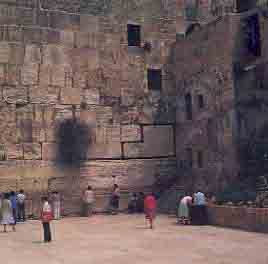Image Details

Leen Ritmeyer
Barclay’s Gate: Although most of Barclay’s Gate (4) survives, little of it can be seen today. Named for its discoverer, the 19th-century British architect J. T. Barclay, this gate in the western wall of the Temple Mount has mostly disappeared behind later construction and beneath the risen street level. Seven courses of Herodian ashlars are visible in the western wall. The first three courses above plaza level formed the upper part of the gate’s northern doorpost. Small stones now block half of the upper part of the gate’s former doorway. The other half of the blocked doorway is obscured by the earthen ramp and wall leading up to the Moor’s Gate, the present access to the Temple Mount. The wall at right in the larger photo, perpendicular to the Temple Mount’s western wall, supports the ramp. A sign is visible, upper right, above the arch of the Moor’s Gate. Almost half of Barclay’s Gate’s massive lintel is visible (outlined in the photo), extending from above the doorpost across the top of the blocked doorway. In its entirety, the lintel measures about 27 feet long and 7 feet high.
